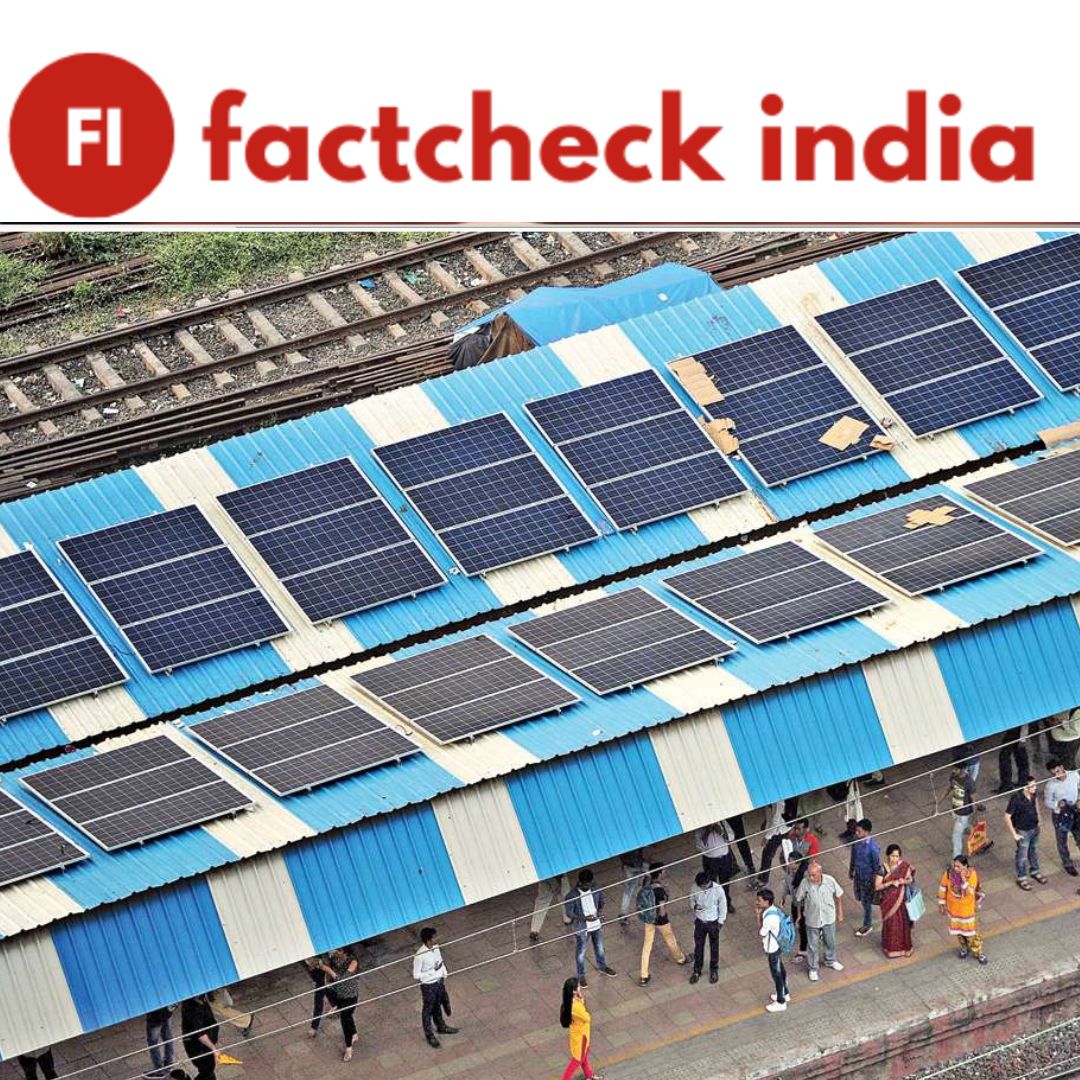Viral Claim Investigation
A compelling image has been making rounds across social media platforms, accompanied by claims that sound almost too good to be true. The viral post alleges that an innovative Indian startup named Sun-Ways has revolutionized sustainable infrastructure by installing removable solar panels directly between railway tracks.
The circulating claim suggests:
- Zero disruption to existing rail operations
- No additional land requirements
- Annual electricity generation exceeding one terawatt-hour
- Sufficient power capacity for over 200,000 households
- A breakthrough “game-changing” approach to renewable energy
Our Investigation Process
Initial Research Approach
Our fact-checking team conducted comprehensive searches using targeted keywords including “Indian railways solar panels Sunways” and related terms. The initial investigation aimed to locate official government announcements, credible news coverage, or ministry statements regarding this supposed groundbreaking project.
What Factcheck India Found?
However, our research uncovered fascinating international developments that appeared directly connected to the viral imagery.
Key Finding 1: An NDTV report published on April 29, 2025, revealed crucial information about a Swiss-based solar technology startup called Sun-Ways. The report detailed their innovative approach to utilizing railway track spaces for sustainable energy generation through solar panel installation.
Key Finding 2: Further investigation led to a Euro News article from October 14, 2024, describing an unprecedented solar panel deployment project in Switzerland. The report highlighted how these panels would be installed “like carpet” on railway tracks in what was described as a world-first initiative.
According to the Euro News coverage, Sun-Ways CEO Joseph Scuderi emphasized the groundbreaking nature of their project: “This will be the first time that solar panels will be installed on a railway track with trains that pass over them.” This statement clearly indicated the project’s Swiss origins rather than Indian implementation.
Official Website Verification
To ensure accuracy, we examined Sun-Ways’ official website for authentic project details.
Project Specifications:
- Location: Buttes, Neuchâtel canton, Switzerland
- Launch Date: April 24, 2025
- Scale: 100-meter photovoltaic installation on active railway infrastructure
- Status: Successfully operational on traffic-bearing railway lines
Global Expansion Plans: The official documentation revealed Sun-Ways’ international ambitions, including collaborations with SNCF in France, projects in Canada and South Korea, and ongoing discussions with potential partners in China, Australia, and the United States. Notably, India was absent from these expansion plans.
Image Authentication
Our reverse image search yielded definitive results about the viral photograph’s origins.
Discoveries:
- The uncropped version appeared in a May 19, 2025, article celebrating Switzerland as the first nation to successfully install solar panels on railway tracks
- An Instagram post from May 9, 2025, correctly identified Switzerland as the location, claiming the installation could power 300,000 homes without disrupting train services
- Multiple international news outlets featured the same image while reporting on Switzerland’s pioneering solar railway project
The Reality Behind the Claim
What Actually Happened
Switzerland’s Sun-Ways achieved a genuine technological milestone by becoming the world’s first company to successfully install solar panels on active railway tracks. Their innovative approach addresses multiple sustainability challenges:
Technical Achievements:
- Seamless integration with existing railway infrastructure
- Zero disruption to train operations
- Efficient space utilization of railway corridors
- Substantial renewable energy generation capacity
Project Impact: The Swiss installation demonstrates significant potential for railway-based solar energy generation, with capacity estimates suggesting power generation sufficient for hundreds of thousands of homes.
The Misinformation Element
The viral claim represents a classic case of geographical misattribution, where a legitimate international innovation was falsely presented as an Indian achievement. This type of misinformation often spreads rapidly because:
- Patriotic Appeal: Claims about domestic innovation generate emotional engagement
- Technical Complexity: Most readers lack expertise to immediately identify inconsistencies
- Viral Nature: Impressive-sounding achievements encourage sharing without verification
Fact-Checking Methodology
Red Flags Identified
Several indicators suggested the claim’s inaccuracy:
- Absence of coverage in major Indian news outlets
- No official government or railway ministry announcements
- Lack of corporate press releases from Indian companies
- Missing technical specifications typically accompanying major infrastructure projects
Verification Standards
Our investigation followed established fact-checking protocols:
- Cross-referencing multiple independent sources
- Consulting official government and corporate websites
- Employing reverse image search techniques
- Verifying timeline consistency across sources
Key Takeaways:
- Always verify the source and location of impressive infrastructure claims
- Cross-reference with official company websites and government sources
- Be particularly skeptical of claims lacking official confirmation
- Use reverse image searches to authenticate viral photographs
- Consider the plausibility of claims that seem too remarkable
Why This Matters
Misinformation about technological achievements can:
- Undermine public trust in legitimate innovations
- Create unrealistic expectations about domestic capabilities
- Distract from actual progress in renewable energy sectors
- Spread false narratives about international competition
Final Advice: Before sharing impressive claims about technological breakthroughs, especially those involving major infrastructure projects, always verify through multiple credible sources. The truth about innovation is often remarkable enough without embellishment.
Conclusion: Misinformation Confirmed
Verdict: FALSE
The viral claim about an Indian startup installing solar panels between railway tracks is definitively false. The project exists, demonstrates remarkable innovation, and shows genuine promise for sustainable infrastructure development – but it’s a Swiss achievement, not an Indian one.

